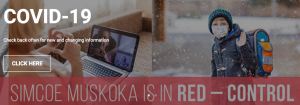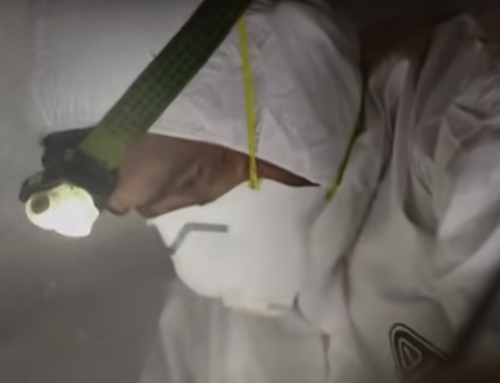Are you in the Simcoe-Muskoka Health Unit region? These NEW instructions for business went into effect as of March 11, 2021, and have now been shared with your Chamber. Here is the new set of instructions (updating instructions from December 2020) followed by the entire letter from the Health Unit, which also clarifies any businesses that might be exempt from these new instructions.
Your Chamber is also meeting today with Dr. Charles Gardner, Medical Officer of Health for the Health Unit, to make sure your concerns are heard — concerns you have expressed through surveys and direct contact with Chamber staff. Thank you for your input.
 Read full instruction letter here: NEW March 11 Instructions_re_workplaces_Final or skip to the updated instructions listed below.
Read full instruction letter here: NEW March 11 Instructions_re_workplaces_Final or skip to the updated instructions listed below.
Instructions to persons responsible for businesses and organizations from Dr. Gardner:
Effective March 11, 2021 at 12:01 a.m., I am instructing all persons responsible for a business or organization in the County of Simcoe, District of Muskoka, City of Barrie, and the City of Orillia to implement the following measures:
- Appoint a Compliance Officer responsible for the implementation of a COVID-19 safety plan (as described in the Reopening Ontario Act and/or its Regulations, as amended) and the compliance with that safety plan, as well as the implementation and compliance with all required and recommended occupational health and safety and infection prevention and control measures.
- Enable remote work for workers, where reasonably possible, to reduce the number of workers exposed to the workplace.
- Ensure workplace active screening1 is conducted daily for all workers attending the workplace. Screening should occur before or when a worker enters the workplace at the beginning of their day or shift. Workers with COVID-19 symptoms, or who have been identified as a close contact of a person diagnosed with COVID-19, are to be immediately excluded from work and encouraged to self-isolate and seek assessment and testing.
- Ensure that physical distancing of workers takes place by at least 2 metres throughout the workplace, where reasonably possible, and during eating and rest periods (i.e. lunchrooms, change rooms). One-way walkways and workflows shall be provided where applicable to reduce the potential for and occurrence of close physical interaction between individuals, including between workers.
- Physical barriers2 (such as plexiglas) should be used where reasonably possible, in particular in environments where physical distancing cannot take place. Physical distancing is preferable to the use of barriers where reasonably possible.
- For the indoor area of the premises, which is accessible to members of the public, ensure each worker wears a mask or face covering that forms a barrier with the skin in a manner that covers their mouth, nose and chin, and as best as possible, maintains a physical distance of at least two metres from every other person while in the indoor area. A face shield alone is not considered adequate covering of the face. Reasonable exceptions are permitted for those who cannot tolerate masks or face coverings. In addition, all workers are required to wear eye protection if in the course of their duties they are required to come within 2 metres of another person who is not wearing a mask or face covering in a manner that covers that person’s mouth, nose and chin during any period when that person is in an indoor area. Even if the other person is wearing a mask or face covering, workers should wear eye protection if they are required to come within 2 metres of the individual and the interaction is expected to last 15 minutes or longer.
- For the indoor area of the premises, which is not accessible to members of the public, ensure each worker wears a mask or face covering that forms a barrier with the skin in a manner that covers their mouth, nose and chin, and eye protection unless they are able to maintain a physical distance of at least two metres from every other worker. If eye protection is not worn and two metres distance is not maintained for 15 minutes or longer, then workers may be considered close contacts requiring 14 days of self-isolation, upon public health investigation of a co-worker diagnosed with COVID-19. A face shield alone is not considered adequate covering of the face.
- If a worker is providing direct care to a suspect or confirmed case of COVID-19, regardless of where in the premises this occurs, ensure the worker wears appropriate personal protective equipment (PPE). A point-of-care risk assessment must occur and at a minimum, PPE must include a medical mask and eye protection. A face shield is not a replacement for a medical mask of face covering.
- If a worker, in the course of providing a service indoors, is required to come within two metres of another person who is not wearing a mask or face covering and there is no separation (by physical barrier) between the worker and the other person, ensure the worker wears appropriate personal protective equipment (PPE). At a minimum, this would include a medical mask and eye protection. A face shield is not a replacement for a medical mask or face covering.
- Ensure supplies and facilities are provided for adequate hand hygiene to take place in work and rest/eating areas within the workplace including the supply of 60-90% alcohol-based hand rub for workers and clients.
- Take appropriate infection prevention and control measures including environmental cleaning in all areas accessible to the public, including washrooms, check-out counters, concession stands, and other high-touch surfaces (i.e. doorknobs, accessible/elevator buttons, pay machines, etc.) using disinfectants with a drug identification number (D.I.N.) while ensuring manufacturer instructions for use are followed.
- Minimize instances of more than one individual per vehicle for driving associated with work, and when unavoidable, ensure face coverings (preferably medical masks) are supplied to and used by each individual, ensure distancing to the degree most possible, and ensure the use of increased ventilation to the outdoors (i.e. through a partially open window) in vehicles, where possible. If the travel time is expected to be 15 minutes or longer, eye protection should be provided to individuals.
- Conduct, or have the property owner or landlord conduct a regular review of heating, ventilation, and air conditioning (HVAC) systems in the workplace, except motor vehicles, to ensure they are functioning and in good working order.
- Ensure that upon request from SMDHU, that information requested is provided to SMDHU as it relates to information required for case and contact management as well as outbreak management. This may include but is not limited to, accurate and updated contact information for all workers (and clients if prescribed in the Reopening Ontario Act and/or its Regulations, as amended), site plans and staff schedules. In addition to legislated requirements under the Occupational Health and Safety Act, 1990, ensure any further instructions, directions and guidance provided by SMDHU, the Government of Ontario and/or the Government of Canada pertaining to COVID-19 are followed. This may include ensuring adherence to isolation orders issued to employees, ensuring the required public health measures such as active screening and physical distancing are always maintained within a workplace and supporting all aspects of investigations and outbreak management related to communicable diseases, including COVID-19, conducted by SMDHU.
Businesses are required to comply with the above instructions as provided by the Reopening Ontario (A Flexible Response to COVID-19) Act, 2020 and its Regulations as they are advice, recommendations and/or instructions of a public health official and shall be in full force and effect despite any changes to the SMDHU’s zone status colour or stage of reopening under the Reopening Ontario (A Flexible Response to COVID19) Act, 2020 as may be amended from time to time.



